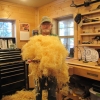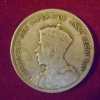Gouges where the crank (the curved bit) is short and tight towards the cutting end are called 'shortbents', sometimes 'spoon' gouges - though the flat ones hardly look like spoons.
There are 2 distinct types:
Because of their different functions, the way you use and sharpen each type of shortbent is distinct ...

| 21 July 2024 21:59
Darrin - Sorry, far too long ago for me to remember why I originally made it! The thing about making special tools is that they are usually demanded by one particular job, like digging out the pocket in a carved shirt; getting in places where other tools won't reach. Some I've made were perfect for the jod but never used again!

| 16 July 2024 21:00
Hi Chris. I just came across your book "Tools, Materials and Equipment",vol.1. On page 39, fig. 2.52 shows a shortbent tool you made. This looks exactly like the tools I just bought. I'm wondering what type of project you made it for and how you used/use it. Thanks!

| 11 July 2024 15:43
Darrin - You probably have what are called 'knuckle' gouges, very useful for deep recesses - sometimes the only tool that will do the job.
Yes, holding the tool while sharpening can be tricky, but do-able with practice. I'd mock up your sharpening stone from go through the motions until you feel confident before sharpening proper.
Keep focussed on the contact between bevel and stone surface.
Also, with an edge that is going to make a tight scoop before exiting the wood: you can round the bevel into the blade, losing the heel. The curve of the bevel sympathises with the tight scoop and helps the tool move smoothly.
No secondary bevel. Tight inner bevel for strength.
This of course goes against the normal pattern of keeping the bevel flat and rounding the heel just a little.
Have a go!

| 10 July 2024 23:46
Hi Chris. I just bought 3 very interesting Addis short bent gouges that have extremely short, tight cranks. So much so that when sitting on the bench, the cutting edge points almost directly to the ceiling. Indeed, to engage the cutting edge on a flat surface, the tool's handle actually has to pass 90 degrees. So reaching into very deep recesses, like deep cups or bowls, even into the junction between wall and bottom for example, without touching the sides, is quite easy. But it also presents some sharpening challenges. I've been able to sharpen the smallest tool much like any other spoon gouge, but for the larger ones (1/2 and 3/4), the weight of the handles makes maintaining the correct sharpening angles very tricky. I'm wondering if you have any tips? Thanks!

| 04 July 2019 08:35
Jof - It's a bit of a personal thing, but my take is:
1) I don't add an inside bevel to shortbent gouges, though I do take off any wire edge left from sharpening with a fine slipstone and strop the inside. It's just not necessary for the way these tools are used, compared to straight gouges. - for example they are never used 'upside down'.
2) The flat (#3) shortbents used for finishing backgrounds are sharpened as ordinary gouges, with a single flat bevel. I guess you could add an inside bevel here to give you a stronger, longer outside bevel.
The spoon-type gouges are used with a scooping action: The handle starts high and then drops through the cut - yes? Thus the rounded bevel helps the edge slip through the cut, and a sharp heel would tempt you to lever.
The best thing is to sharpen the tools as best you think fit, then get carving with them. Don't take what I say as gospel; rather, see how they perform and feel free to alter their configuration if you can see how they might work better.

| 03 July 2019 11:45
A few questions about spoon/shortbent gouges;
1) Do you add internal bevels? I don't seem to see a sign of internal bevels in the video.
2) You mention they don't have a heel - rather, a long curve - but are they still sharpened at a low angle (at the tip) like other gouges? If so, how do you judge the angle given they are curved all the way from the cutting edge?

| 12 January 2016 09:37
Hello Mr. Pye,
I have a few questions. First off, what is the difference between a 'shortbent' or 'spoon' gouge and simply a 'bent' gouge? Secondly, what would you recommend as a good starting sweep for a spoon gouge? Shallower or deeper?
Thanks,
Liam

| 12 January 2016 09:36
Brian - There are straight gouges and there are bent ones. It doesn't tell you much if you just say 'bent gouge' because the tools can be bent in one of three ways: (1) The bends can occupy the whole length of the shank; this would be a 'longbent' tool - useful for long, slow curves. (2) The bend can just take up the end near the cutting edge: this is a 'shortbent' another name for this is 'spoon' - so a spoon gouge is a shortbent. (3) If the short bend is reversed, it's a 'backbent' tool - this is a fairly specialised tool. You do here the term 'knuckle gouge: this ia an extreme form of shortbent. Most of my bent tools are shortbent, which for my sort of work are the most useful profiles. What I suggest you get? Don't get any! Or rather, use the straight gouges you have, then when one won't get into a recess because the shank fouls the edge of the wood, THEN you know you need a the same gouge as as shortbent - and you can match straight with bent. That way you'll build up a set of tools that is particular to the sort of work and the carving jobs you need to do.

| 25 December 2013 21:08
Chris and Carrie, The collection of finished carvings that you used to show the application of specific tools was super. SO much information compacted into such a small run of video. And this is exactly what a beginner like me is looking for (especially when I run up against a "wooden wall" in my carvings and go, "How do I get in there!" Thanks. (and... more tools in my bag...)

| 24 November 2013 22:33
Very good lesson. Well explained, I am learning a lot.
thanks
Roy

| 21 November 2013 00:10
Thank you for a vary informative narration not only describing each specific tool but how it functions during the course of carving.
Charles Murray

| 20 November 2013 16:46
Chris, a good basic video: thumb-lever. I'm going to start exercising that and finally learn how to use the spoon gouges better. Thanks.

| 20 November 2013 12:22
Very interesting how each tool is used and solves a problem that I am facing with a carving.